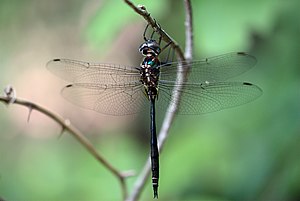Somatochlora filosa
| Somatochlora filosa | ||||||||||||
|---|---|---|---|---|---|---|---|---|---|---|---|---|

Somatochlora filosa |
||||||||||||
| Systematics | ||||||||||||
|
||||||||||||
| Scientific name | ||||||||||||
| Somatochlora filosa | ||||||||||||
| ( Hagen , 1861) |
Somatochlora filosa is a species of dragonfly from the family of the falcon dragonflies (Corduliidae), which belong to the large dragonflies (Anisoptera).
features
Imago
The imago of Somatochlora filosa measures between 55 and 66 mm, of which 42 to 52 millimeters on the abdomen ( abdominal ) omitted, making it one of the largest species within the genus. The pattern typical of the genus is composed as follows on the long and slender abdomen: There are three stripes on the first and second segments . These extend to the genital lobes on the second segment of the males . The intersegmental membranes are light at the end of the shorter segments, otherwise black. The abdominal appendages and the cerci are black.
The part of the chest ( thorax ) to which the wings attach, the so-called pterothorax , is dominated by two lateral stripes. While the first strip is long and narrow, the second is wide and short. The unusually wide hind wings measure 36 to 45 millimeters. The wings are transparent, except for a small brown area near the wing mark ( pterostigma ).
The color yellow predominates on the face. This is framed in black from the lower edge of the labrum up to the front , which is metallic blue-green at the top. In the end, the occiput is brown.
larva
The larva of the species is greenish and slightly brownish on the sides. In the last larval stage, it reaches between 19 and 22 millimeters in length, of which about 13 to 14 millimeters are on the abdomen. The widest segment is the sixth, which reaches 7.5 to 8.8 millimeters. At the rear edge and along the side keel, the individual tergites are covered with hairs. There are scattered hairs on the top. The hairs are joined by dorsal spines on the fourth and fifth to ninth segments and lateral spines on the eighth and ninth segments. The cerci are about as long as the ninth and tenth segments combined.
The brownish part on the side is shown by two points on the thorax. One on the front edge of the mesothorax and one behind the spiral of the mesothorax. The wing sheaths reach between 5.4 and 6.7 millimeters and are a little darker at the base. The legs are light brown and have bristles in the femur and tibia area.
While the front of the 6.2 to 6.7 millimeters long and 2.1 to 2.3 millimeters wide head is brown, the vertex and the top are greenish. The antennae consist of seven segments, the first two of which are considerably sturdier.
development
The eggs develop at room temperature within three to four weeks and change their color from white on the first day to red-brown on the second day. After hatching, the Pronymphe follow probably 13 larval stages. In laboratory experiments this development took up to 669 days in the females. The males developed significantly faster with up to 280 days.
Spread and time of flight
The species is common in the southern United States . It flies between June and December.
literature
- James George Needham , Minter Jackson Westfall , Michael L. May : Dragonflies of North America. Revised edition. Scientific Publishers, Gainesville FL 2000, ISBN 0-945417-94-2 .
- Sidney W. Dunkle: The Larva of Somatochlora filosa (Odonata: Corduliidae) , The Florida Entomologist , 60 (3) 187-191, 1977